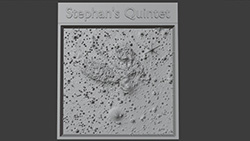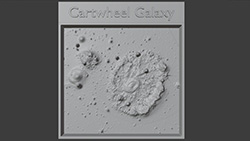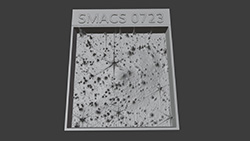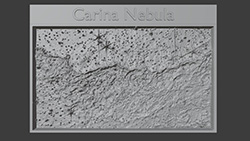CXC Home | Search | Help | Image Use Policy | Latest Images | Privacy | Accessibility | Glossary | Q&A
NASA's Chandra Adds X-ray Vision to Webb Images
These four objects were among the first publicly released images from the James Webb Space Telescope. Chandra had already observed these sources and these composite images show how these two space-based telescopes complement each other. These images span a range of different types of objects, including a cluster of galaxies (SMACS J0723), a galaxy group (Stefan’s Quintet), a star-forming nebula (Carina), and a galaxy (Cartwheel). In each image, the X-rays from Chandra show higher-energy processes than the infrared view from JWST. Additionally, infrared data from the Spitzer Space telescope is included in the Stephan’s Quintet composite.
(Credit: X-ray: NASA/CXC/SAO; IR (Spitzer): NASA/JPL-Caltech; IR (Webb): NASA/ESA/CSA/STScI)
These four objects were among the first publicly released images from the James Webb Space Telescope. Chandra had already observed these sources and these composite images show how these two space-based telescopes complement each other. These images span a range of different types of objects, including a cluster of galaxies (SMACS J0723), a galaxy group (Stefan’s Quintet), a star-forming nebula (Carina), and a galaxy (Cartwheel). In each image, the X-rays from Chandra show higher-energy processes than the infrared view from JWST. Additionally, infrared data from the Spitzer Space telescope is included in the Stephan’s Quintet composite.
(Credit: X-ray: NASA/CXC/SAO; IR (Spitzer): NASA/JPL-Caltech; IR (Webb): NASA/ESA/CSA/STScI)
2
3D Printable Files: Stephan's Quintet Tactile Plate (3D Print Credit: NASA/CXC/A. Jubett & K.Arcand, using software by Tactile Universe/N. Bonne & C. Krawczyk & Blender)
This tactile plate depicts a group of galaxies, Stephan’s Quintet, as a physical relief map based on the intensity of X-ray data captured by Chandra and infrared data captured by the Webb and Spitzer Space Telescopes. The file for this plate can be downloaded and 3D-printed for learners to touch.
The plate of Stephan’s Quintet shows five galaxies. Two of the galaxies appear close together at the center of the plate. One appears directly above, and another slightly to our left near the bottom of the image. Each of these four galaxies presents as an irregular dot of brilliant light surrounded by a glowing haze. A fifth galaxy peaks out from the center left in an oval shape marbled with a tangle of lines. Similar tangles appear around the two galaxies at the center of the image, and the galaxy above them. Above the two galaxies at the center is a squiggly cloud. This is a shock wave uncovered by the Chandra data. Scattered across the image are many specks — gleaming stars and distant galaxies.
The plate of Stephan’s Quintet shows five galaxies. Two of the galaxies appear close together at the center of the plate. One appears directly above, and another slightly to our left near the bottom of the image. Each of these four galaxies presents as an irregular dot of brilliant light surrounded by a glowing haze. A fifth galaxy peaks out from the center left in an oval shape marbled with a tangle of lines. Similar tangles appear around the two galaxies at the center of the image, and the galaxy above them. Above the two galaxies at the center is a squiggly cloud. This is a shock wave uncovered by the Chandra data. Scattered across the image are many specks — gleaming stars and distant galaxies.
3
3D Printable Files: Cartwheel Galaxy Tactile Plate (3D Print Credit: NASA/CXC/A. Jubett & K.Arcand, using software by Tactile Universe/N. Bonne & C. Krawczyk & Blender)
This tactile plate depicts the Cartwheel galaxy as a physical relief map based on the intensity of X-ray data captured by Chandra and infrared data captured by the Webb Space Telescope. The file for this plate can be downloaded and 3D-printed for learners to touch.
The Cartwheel galaxy presents as a disk with an outer ring, and a solid, slightly off-center spiraling core. Linking the smooth core and the irregular outer ring are wispy plumes of silicate dust which resemble twisted spokes on a bicycle wheel. At the upper left of the plate are two companion galaxies which appear to be about the same size as the core of the Cartwheel galaxy. One companion galaxy is shaped like a backwards S, and is marked by bright dots and tangles of fine crinkly lines. Below it, the second companion galaxy appears delicate and smooth, like a faded swirl of cotton candy.
The Cartwheel galaxy presents as a disk with an outer ring, and a solid, slightly off-center spiraling core. Linking the smooth core and the irregular outer ring are wispy plumes of silicate dust which resemble twisted spokes on a bicycle wheel. At the upper left of the plate are two companion galaxies which appear to be about the same size as the core of the Cartwheel galaxy. One companion galaxy is shaped like a backwards S, and is marked by bright dots and tangles of fine crinkly lines. Below it, the second companion galaxy appears delicate and smooth, like a faded swirl of cotton candy.
4
3D Printable Files: SMACS J0723 Tactile Plate (3D Print Credit: NASA/CXC/A. Jubett & K.Arcand, using software by Tactile Universe/N. Bonne & C. Krawczyk & Blender)
This tactile plate depicts the galaxy cluster SMACS 0723 as a physical relief map based on the intensity of X-ray data captured by Chandra and infrared data captured by the Webb Space Telescope. The file for this plate can be downloaded and 3D-printed for learners to touch.
Galaxy cluster SMACS 0723 contains hundreds of individual galaxies in a sea of black space. Here the galaxies resemble specks of light. Some feel with diffraction spikes radiating from the center. Some feel like tiny swirling pinwheels. Some of the galaxies located far behind the cluster resemble short arcing streaks, their light having been bent by the mass of galaxies in the cluster. Near the center of the image, where some of the brightest galaxies reside, is a faint, haze. This is superheated gas with a total mass of about 100 trillion times that of the sun, revealed by the Chandra observatory.
Galaxy cluster SMACS 0723 contains hundreds of individual galaxies in a sea of black space. Here the galaxies resemble specks of light. Some feel with diffraction spikes radiating from the center. Some feel like tiny swirling pinwheels. Some of the galaxies located far behind the cluster resemble short arcing streaks, their light having been bent by the mass of galaxies in the cluster. Near the center of the image, where some of the brightest galaxies reside, is a faint, haze. This is superheated gas with a total mass of about 100 trillion times that of the sun, revealed by the Chandra observatory.
5
3D Printable Files: NGC 3324, Carina Nebula Tactile Plate (3D Print Credit: NASA/CXC/A. Jubett & K.Arcand, using software by Tactile Universe/N. Bonne & C. Krawczyk & Blender)
This tactile plate depicts the Carina Nebula as a physical relief map based on the intensity of X-ray data captured by Chandra and infrared data captured by the Webb Space Telescope. The file for this plate can be downloaded and 3D-printed for learners to touch.
The Carina Nebula resembles a mountain range backed by a hazy night sky. A curtain of dust and gas in the nebula occupies the bottom half of the plate. The sky-like area above is streaked with vertical bands of haze which rise from the nebula below. Faint cloudy areas show hot gas that was blown away from massive stars. A starfield of specks blankets the entire plate. Three thin long diffraction spikes entering the image at our upper right hint at the presence of a bright star just out of view.
The Carina Nebula resembles a mountain range backed by a hazy night sky. A curtain of dust and gas in the nebula occupies the bottom half of the plate. The sky-like area above is streaked with vertical bands of haze which rise from the nebula below. Faint cloudy areas show hot gas that was blown away from massive stars. A starfield of specks blankets the entire plate. Three thin long diffraction spikes entering the image at our upper right hint at the presence of a bright star just out of view.
Return to NASA's Chandra Adds X-ray Vision to Webb Images (October 4, 2022)




















